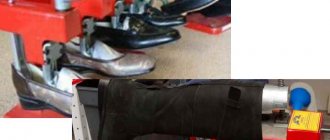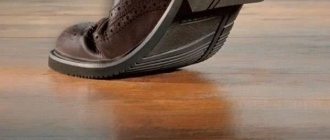Most people, with the arrival of autumn or spring, purchase new shoes and notice that when they take off the purchased boots or shoes, tights or socks have acquired an undesirable color. The reason for dyeing is that the dye transfers from leather products to the feet under the influence of heat and high humidity. If you are the owner of just such a product, then you need to know why shoes are painted from the inside and what to do in this case.
Causes of unwanted coloring
Many people think that dyed new things are of poor quality, however, this is not always the case.
New boots or shoes that stain the heel rather than the entire foot are often normal. For example, the product is made of suede, with a small insert inside, which is designed to prevent the boots from chafing while moving. In this case, moisture entering this insert causes the suede to begin to fade and stain the heel.
Often, manufacturers, trying to save money, use low-quality and cheap materials as insoles. Therefore, in order to avoid the question of what can be done to prevent shoes from being painted on the inside, it is recommended to purchase shoes with a light-colored insole. It doesn't stain the legs as much as dark material.
In addition to manufacturing defects, we can highlight other reasons for the staining of stockings from boots:
- while wearing the product, the wearing rules were not followed: the shoes periodically did not “rest” and regularly remained wet;
- The shoes are very old, the top of the insoles have worn off, resulting in the paint being exposed.
If the shoes stain the entire foot, then this means that they are made of poor quality material and are in fact defective.
How to remove suede paint?
Suede paint contains nitro components, which are quite difficult to remove. Although the cleaning process is labor-intensive, stains can still be removed.
To do this, you need to use special detergents:
- Alcohol. You need to moisten a piece of cloth with it and wipe the stain. Then rinse the boot with plenty of water.
- Special stain removers for suede paint. There are a huge number of them now, so you need to read the instructions for use on the packaging.
- Solvent (for example WD-40). The principle of operation is the same as with alcohol. However, you need to be more careful with this product, as it is classified as an aggressive substance.
Shoe care rules
There are general rules for caring for shoes. Here are some recommendations that can prevent staining:
- Buy boots or shoes with thick insoles in a light color.
- Shoes should always be dried after wearing and shoes should never be worn when wet.
- If the problem is poor quality insoles, then replace them with better ones.
- Use shoe sprays; they create a slight film and prevent staining.
Following these simple rules will protect you from unpleasant emotions caused by unwanted coloring of stockings.
Why do shoes stain your feet?
Before choosing a way to fix a problem, it is necessary to determine the factors that led to its occurrence. This will help you choose an effective product that can prevent foot staining in the future.
Main reasons:
- Low quality product. Due to the weak purchasing power of the population, manufacturers are forced to produce cheap shoes. It is made from low-quality materials that can stain your feet or cause an allergic reaction.
- Heavy sweating. This reason is often found among sports and outdoor enthusiasts. People move quickly, which causes them to produce a lot of sweat. It contains dozens of substances that can dissolve paint and transfer it to the skin.
- Bad weather. On a rainy day it is difficult to walk down the street without getting your feet wet. Moisture promotes the rapid transfer of paint to the skin.
- Improper care of boots. When treating shoes with various protective compounds, you can accidentally apply a substance that will corrode the paint and allow it to be absorbed into the pores on the skin.
- Long period of operation. Wearing one pair of shoes for a long time leads to rubbing of the insoles. Because of this, a layer of paint is exposed, which leaves its marks on human skin.
- Storage errors. In most cases, the buyer does not pay attention to the characteristics of the composition that coats the inside of the shoes. Because of this, situations arise when shoes left near heating devices begin to stain your feet. The same problem arises when storing boots in places where they are exposed to direct sunlight.
Ways to solve the problem
New shoes with the identified problem can be returned to the shoe store.
If you still have the sales receipt and the product is completely new, then you should receive a full refund. Remind the shoe store that, according to GOST, unstable dyeing during manufacturing is not allowed. That is, one way or another, the truth is completely on your side, and, if anything happens, the court will be able to prove it. But do not forget, in order to return a product, it must be unworn.
If you can’t get your money back, you can write a statement to the consumer rights service. After the application, the examination will make a decision: return your money for the shoes, or keep the product with you. The consumer must pay for this examination. The application must be accompanied by a payment receipt and documents for the shoes, which must be issued at the time of purchase.
Naturally, not all people will want to contact the consumer rights society for a pair of shoes or boots, but the seller, seeing such determination, may agree to return your money.
If you were unable to return your shoes because they are not entirely new, then you can try traditional methods.
Traditional methods
There are so-called grandmother’s or folk methods that have been used since ancient times. Despite the fact that these recommendations are as old as the hills, they are still popular due to their effectiveness.
- Vinegar. This is a great help in solving the problem of what to do if the shoes are painted on the inside. And everything is explained by the fact that acid is an excellent fixative. To use this product, you need to wet a sponge with vinegar and treat the product from the inside, then leave to dry. Airing your shoes outside will help remove the vinegar smell.
- Medical alcohol. This product can also help in treating shoes. To do this, moisten a sponge with medical alcohol and wipe the inside of the shoes. However, one important nuance must be taken into account: alcohol will not be able to fix the paint; on the contrary, it is a means that can simply wash it off.
- Hair fixation spray. Hairspray can help fix the paint on the sole; it can be purchased at any supermarket. You can also treat shoes with the product, but you must not forget that the varnish tends to wash off, and, accordingly, this method is not suitable for cloudy weather.
- Talc. This substance can also help solve the problem of what to do if the inside of shoes is painted. You can use regular starch instead of talc. The powder must be rubbed into the skin, and then carefully remove all excess.
- Burr oil. This product is also treated from the inside. You must wait until the substance is completely absorbed.
It must be remembered that any processing is carried out only in a completely dry state of the product, otherwise there will be no positive result from these efforts.
Modern means
On store shelves you can find modern products: AntiColor, StopColor.
They were developed by shoe manufacturers with customers in mind. Use paint fixatives only from well-known manufacturers, for example: Tarrago, Saphir, Salamander. With these tools you can solve the problem quite quickly. The easiest way to get rid of excess paint is to remove it using special products that artists usually use to clean brushes. By using this solution, you remove, rather than fix, the color pigments of the paint on the shoes.
Choose an odorless composition, otherwise after a certain time you will need to struggle with getting rid of the unpleasant “aroma”.
You can also put on old socks and walk around the apartment in new shoes, allowing the paint to transfer to them. Probably, after this procedure, the shoes will no longer stain the stockings or tights.
A few simple recipes for dyeing shoes from the inside
If you didn’t notice the problem with your feet and tights getting dirty even during the fitting, and this unpleasant situation caught you already while wearing them, then the recommendations and tips below will help you avoid this effect in the future:
- Use of talc. Take regular talcum powder and sprinkle a little inside your shoes. Using a cotton pad, treat the surface, distributing more product to the areas of greatest staining. Remove excess talc that is not completely rubbed into the material using a dry sponge or cloth (cotton cloth).
- Vinegar solution. First, mix table vinegar with cold water at a ratio of 1 to 2 (for example, in a deep bowl, dilute three tablespoons of vinegar with six tablespoons of water). Soak a cotton swab in the resulting liquid and generously lubricate the shoes in the areas where they are painted. After the shoes have been treated, place them in a well-ventilated area until they dry completely. If you smell vinegar after drying, you can use foot deodorant.
- Regular hairspray. Spray curl hairspray inside the shoes and blot off any excess foam with a sponge. After the procedure, leave the shoes to dry. To achieve the best effect, this operation should be repeated 2-3 times.
- Burr oil. This recipe for staining socks and tights is only suitable for shoes made of artificial materials (faux leather, leatherette), since oil stains can seep through the natural leather and stand out from above. The inside of the shoes is wiped with burdock oil (with a moistened cloth) and rubbed into the surface with your fingers. Shoes should be put on after such a procedure only after the inside has completely dried.
- Special artistic wash. Not everyone has such a tool in their everyday life, but people who draw can always use this advice. Shoes (boots, boots, etc.) treated from the inside with paint remover will no longer stain legs and stockings. It is best for these purposes to use the most gentle solution intended for washing brushes. This solution is practically odorless and does not corrode the material.
The process of getting rid of paint on legs
If, after all, your feet have acquired an unnatural color from the leather on your shoes, then do not worry. There are a large number of ways that can help solve the problem:
- Treat your toes and heels with a foot file or pumice stone.
- Wash your heel with warm water and soap.
- Treat stained areas of your feet with nail polish remover or alcohol.
After the manipulations, be sure to lubricate your feet with cream.
To prevent problems with dyeing hosiery items from appearing, you can listen to certain recommendations.
Recommendations for preventing staining
To avoid paint on your feet or clothes from shoes, you should adhere to the following recommendations:
- If your feet sweat a lot, use special pharmaceutical products that are aimed at reducing the intensity of sweating. This will help not only from the appearance of paint, but also get rid of the unpleasant smell of shoes.
- Avoid getting wet. If the boots are painted, it is better not to wear them in rainy weather.
- When choosing care products, give preference to proven products. They may cost more, but you will be confident that the shoes will last a long time.
- Treat the inside of the shoes with a special spray (“Anticolor” or “Stopcolor”).
Preventive measures
If your feet sweat a lot, you can purchase special medical products.
They can help get rid of excessive sweating, and the problem with skin coloring will also be solved. Try not to let your shoes get into water frequently, especially when you know that the product you purchased stains your feet; you should not wear these shoes in cloudy weather.
Compositions for processing leather products must be purchased only of high quality. There is no need to skimp so as not to regret it in the future.
Naturally, it is quite ugly and unpleasant if the shoes begin to stain the stockings. However, there is no need to worry about this. Any person can cope with this trifle. Choose only high-quality shoes that will certainly please your feet.
Is this a marriage
It is possible to prove the fact that shoes are defective only when they have not yet been in use. If you come to the store with a claim after wearing it, you will hardly be able to prove anything. It is necessary to take into account that if only the heel is stained, then a defect is quite possible. This is explained by the fact that during production the skin is applied to the heel area with the reverse side. This is done so that the leg does not move out.
How to paint at home
To paint your own shoes, there are many things to consider. Generally, it is recommended to do the following:
- Wash and dry your sneakers. Coat them with a degreasing compound. A special product or a handy solution of laundry soap and ammonia is suitable for this.
- Prepare the room. It is important that it is well ventilated. Dyes often have a strong and pungent aroma. Therefore, children or people with allergies should not be in the room.
- Apply paper tape to areas that you do not plan to paint.
- Shake the paint and apply it in a thin layer to the shoes. It is recommended to do this with a brush. At the same time, there should be no streaks or drips on the surface of the sneakers.
- Leave the sneakers so that the paint is completely absorbed and dry.
- After painting a smooth leather surface, you should apply a special varnish. This will make the texture smoother and shinier.
It is worth considering that it is recommended to dry shoes only at room temperature. Before carrying out work, be sure to wear gloves.
Folk tricks
There are several traditional methods by which you can fix paint:
- Hair fixation spray. If you spray the inside of the shoes several times and let them dry, the paint will adhere better. Usually 3-4 treatments are enough.
- Alcohol. Wipe the inside of your shoes with it and let them dry.
- Burr oil. Rub it thoroughly into problem areas. Let dry in fresh air.
- Vinegar. It will also help you get rid of the smell in your shoes: just wipe all the internal surfaces thoroughly. Dry.
- Talc. Pour it onto a cloth and rub it into the inside of your new boots. Collect the remains with a clean rag. The same thing can be done with baby powder or starch.
Tips for care and use
- It is better, of course, to buy a quality product from a manufacturer proven by experience and time. Although such shoes are more expensive, they will last you longer, and most likely they will not need to be painted.
- Try to purchase shoes with a light-colored heel and insole. Then the likelihood that after half an hour of wear your feet will acquire an unexpected color will be minimized.
- If it is not possible to follow the previous advice, then there is a second one - to prevent staining. To make sure your new boots don't stain your stockings or feet, walk around in your shoes at home for an hour. Wear socks that you don’t mind getting dirty (preferably light ones to see the scale of the problem). First, dip your socks in alcohol mixed with water, or better yet, spray the solution on it so that they become slightly damp.
- Repeat the manipulation until the coloring disappears or at least becomes weaker. The paint will definitely come off in a couple of times.
- Wear shoes appropriate for the weather. Getting water on any shoes other than rubber boots is fraught with consequences. Try to avoid this if possible. If your shoes do get wet, be sure to let them dry completely. Never wear shoes that are even slightly damp - they will definitely stain your feet.
- It’s trite, but proper care is half the battle. Even with low quality shoes. Also, you should not purchase paints and shoe polishes of dubious quality.
- If your feet sweat a lot, consult a specialist at the pharmacy and buy a special drug. It will not only prevent your feet from staining, but will also protect you from discomfort and excess odor.
- Any treatment should be carried out only on dry and clean shoes. Otherwise, all efforts will be in vain.
How to paint sneakers at home
To dye your shoes yourself, you need to follow these steps:
- wash, dry and degrease shoes. To do this, you need to buy special products in the store or use improvised ones. A solution of laundry soap with ammonia copes well with this task;
- prepare the room. Provide fresh air for ventilation. The smell of paint is pungent and pungent; there should be no children or people prone to allergic reactions nearby;
- cover areas not to be painted with paper tape;
- take a brush, shake the paint and evenly apply the coloring matter to the surface in a thin layer, avoiding paint stains and drips;
- leave the sneakers to absorb the paint and dry naturally;
- After dyeing smooth leather, it is recommended to coat the shoes with a special varnish in order to give them smoothness and shine.
Important! Dry your shoes at room temperature. Wear gloves before painting.
How to remove paint from shoes?
Shoes are one of the most important items in your wardrobe. Without it, it is impossible to go for a walk or to work, especially in bad weather. And of course, she requires care. If you provide good care, it will not only look neat, but will also last a long time:
- First of all, you need to clean it from dirt and dust. Don't forget to wash off the dirt from the soles as well. A regular brush will help you with this.
- If the shoes are wet, you should wipe them with a dry cloth.
- Excess water can be removed with a hairdryer.
Important! All subsequent manipulations, taking into account the material your shoes are made of, should be performed only after the shoes have dried.
How to remove oil paint?
Oil paint contains greasy components, so if it gets on your shoes or clothes, you need to take action as soon as possible. A fresh oil stain is much easier to clean than a hardened one. It is very easy to remove with improvised means:
- Laundry soap. They need to lather with a soft brush and treat the damaged part of the shoe, and then rinse under running cool water.
- Butter or vegetable oil. It is applied in a thick layer to the stain. Afterwards, let it stand for a while and remove any remaining oil with a dry cloth or paper.
- White Spirit. Soak a cotton swab in the solvent and apply it to the stain. After 10-15 minutes, treat the area with a cloth soaked in water.
- White clay. This universal product is used not only for cosmetic purposes, but also for household purposes. It is diluted with a small amount of water to form a paste. Then apply a thick layer to the oil stain and allow to dry. The remaining paste is removed with paper.
Important! Frequent use of aggressive chemicals can ruin your shoes. Therefore, in case of any contamination, try to give preference to the safest and simplest ones, alternating them.
What about water-based paint?
Water-based paint is absolutely harmless to the human body. It does not contain persistent coloring components, so it is very easy to clean from any surface.
We recommend: How to remove white mold in the basement?
Let's look at several effective ways to clean shoes from water-based paint:
- Use a soft bristle brush. Since the water-based emulsion dries quickly, you need to wet it a little first. After the stain has soaked, remove it with a brush.
- Using a sponge. It is necessary to wet a soft piece of cloth or sponge and wipe the “colorful” stain.
- Dish gel. Apply a couple of drops to a damp sponge and treat the contaminated area of the shoe. Then rinse the shoes under running water.
These three simple methods don't require much effort and make it easy to remove paint from shoes.
Important! Find out also what is the best paint to choose for shoes so that it protects the material well from any adverse effects and does not stain your flooring.
Professional products
The issue of “dyeable” shoes has become so pressing that products to solve this problem have already appeared on the market (AntiColor, StopColor). The main rules for choosing such a product:
- Give preference to well-known brands: Tarrago, Saphir, Salamander. Yes, they are an order of magnitude more expensive than those that have little-known names. But the result will be as predictable as possible.
- Try to find out if the product has a smell. It is usually very difficult to remove it later.
Advice! Don't ignore the instructions. These remedies are more active than traditional ones. You need to be more careful with them.











